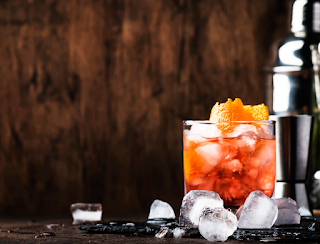Drink connoisseur Linda Vijeh gives Living an overview of bitters
and shows us how to make our own
I just love bitter flavours, much preferring the punch they give when compared with overly sweet sickly
concoctions, although I confess to being partial to Tia Maria with cream on the odd occasion.
The introduction of what is known collectively as ‘bitters’ can make or break a drink, and frequently forms a key part in the resulting character of many cocktails, giving a complexity, bringing maturity and great depth.
In general, they are not intended to be consumed neat due to the bitterness of their flavour, but when added to a classic cocktail such as an Old-Fashioned, or a Manhattan, they add a robust woody spiciness, with hints of tamarind, clove and cinnamon.
Bitters originally started life as a medicine. The best known of these is Angostura bitters, which despite its name contains no medicinal bark from the angostura tree.
It was created in 1824 by Dr Johann Gottlieb Benjamin Siegert as a remedy for sea sickness and stomach ailments.
The original recipe was named after the town of Angostura in Venezuela. Exports to England began in 1830, and the Royal Navy took to adding a few dashing of Angostura bitters to gin, to make what is now known as ‘Pink Gin’, which was said to alleviate stomach ailments.
The list of ingredients used to make traditional bitters reads a little like a who’s who of archaic remedies – a bitter agent, often a tree bark or root, is macerated along with up to 30 or 40 botanical ingredients, including herbs, flowers and spices in strong spirit.
The resulting alcoholic strength of bitters varies widely across brands and styles but is often as high as 44% abv, hence a little goes a long way.
The Ancient Egyptians are thought to have infused medicinal herbs in jars of wine. The ability to distil alcohol, developed in the Middle Ages, made it possible to produce more-concentrated herbal bitters and tonic preparations.
Many digestive bitters are often used in cocktails and are also typically consumed in many European and South American countries, either neat or with ice at the end of a meal. In Trinidad and Tobago, Angostura bitters are often added to coffee.
Some notable examples of cocktail bitters that are quire readily available include:
• Campari (Novara-Milan, Italy): A key ingredient in quite my favourite cocktail at the moment, which many of us will be familiar with, Negroni, made with equal parts gin, red vermouth and Campari, topped up with lots of ice.
• Aperol (Padova, Italy): I am less keen on this as it is a little too sweet for me. It is popular though as an Aperol Spritz, with Prosecco, topped up with soda water.
• Cynar (Padova-Milan, Italy)
• Fernet-Branca (Milan, Italy)
• Jägermeister (Germany)
• Suze (France)
• Underberg (Germany): Sold in 20cl. paper-wrapped bottles, and made with herbs from 43 countries, matured for months in Slovenian oak barrels, this is marvellous as a pick-up after over-indulgence the night before. I can highly recommend it.
• Unicum (Hungary)
Homemade bitters are easy to make, but it does take about four weeks to complete. By doing this you can personalise the recipe to suit your own taste, using a variety of herbs and spices.
How to make your own bitter: The recipe below is for an aromatic-style of bitters, with an emphasis on orange, and is great for use in a variety of cocktails.
• 1 pt. neutral alcohol – vodka or white rum
both work well.
• Dried peel from one orange, without the
pith.
• 1 tsp. cardamom seeds
• 1 tsp. coriander seeds
• ½ tsp. caraway seeds
• 6 whole cloves
• 1oz. sugar
There are two main ways to make bitters. This method combines all of the botanicals and infuse them in the spirit together. Put all ingredients in a jar, keep it in a dark place and give it a good shake every day. Test it occasionally by smelling it and putting a drop or two into water. It should reach the required level of intensity after about four weeks.

